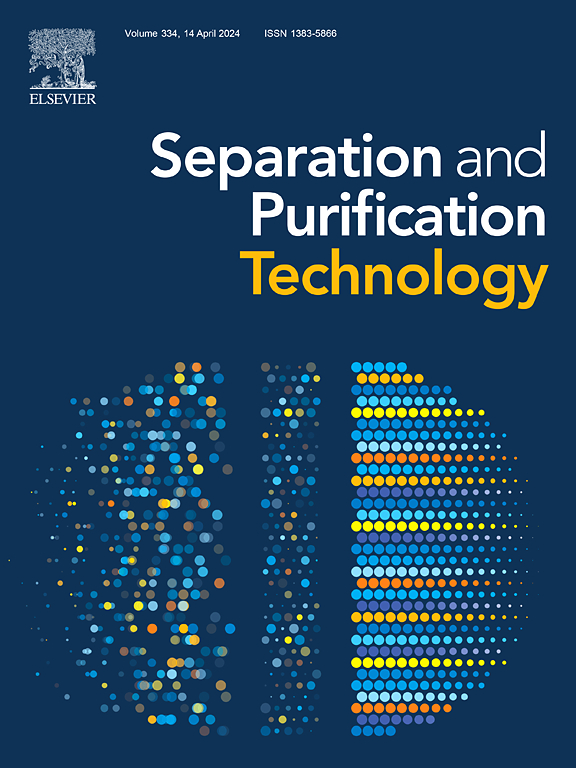Interfacial charge steering in CdS/nitrogen-deficient g-C3N4 heterojunctions boosts solar-driven persulfate activation for PPCPs decontamination
IF 9
1区 工程技术
Q1 ENGINEERING, CHEMICAL
引用次数: 0
Abstract
The persistence of pharmaceuticals and personal care products (PPCPs) in aquatic ecosystems poses severe environmental risks, primarily owing to their incomplete removal by conventional treatment methods and potential for inducing bacterial resistance. While CdS/g-C3N4 heterojunctions exhibit promise for photocatalytic degradation, the role of nitrogen-defect engineering in steering interfacial charge behavior to synergize photocatalysis with persulfate (PS)-based advanced oxidation remains unexplored. Herein, a nitrogen-deficient Z-scheme CdS/g-C3N4 (CdS/N-CN) heterojunction was designed via hydrothermal synthesis to enable solar-driven cooperative photocatalysis and PS activation for PPCPs degradation. The optimized system achieved complete degradation of 10 mg/L sulfamethoxazole (SMX) within 60 min under visible light, achieving a rate constant (0.157 min−1) 29 times higher than pristine g-C3N4. Mechanistic investigations demonstrated dual-pathway operation: a built-in electric field drove Z-scheme charge transfer, migrating electrons from N-CN to CdS while holes in N-CN served as primary oxidants. Meanwhile, electrons from CdS activated PS to generate sulfate and hydroxyl radicals, with the latter transforming into singlet oxygen for supplementary oxidation. This synergistic photocatalysis-PS activation system maintained efficient redox activity while enhancing charge separation, ultimately enabling effective PPCPs decontamination. This research presents a novel strategy for leveraging solar-driven heterojunctions and persulfate chemistry for sustainable water remediation.


CdS/缺氮g-C3N4异质结中的界面电荷转向促进了太阳能驱动的过硫酸盐活化对PPCPs的净化
药物和个人护理产品(PPCPs)在水生生态系统中的持久性构成了严重的环境风险,主要是由于常规处理方法无法完全去除它们,并可能诱发细菌耐药性。虽然CdS/g-C3N4异质结具有光催化降解的前景,但氮缺陷工程在引导界面电荷行为以协同光催化与过硫酸盐(PS)为基础的高级氧化中的作用仍未被探索。本文通过水热合成设计了一个缺氮的Z-scheme CdS/g-C3N4 (CdS/N-CN)异质结,实现了太阳能驱动的协同光催化和PS活化对PPCPs的降解。优化后的体系在可见光下可在60 min内完全降解10 mg/L磺胺甲异唑(SMX),其降解速率常数(0.157 min−1)是原始g-C3N4的29倍。机制研究证明了双途径操作:内置电场驱动Z-scheme电荷转移,将电子从N-CN迁移到cd,而N-CN上的空穴充当初级氧化剂。同时,CdS的电子激活PS生成硫酸盐自由基和羟基自由基,后者转化为单线态氧进行补充氧化。这种协同光催化- ps激活系统在增强电荷分离的同时保持了高效的氧化还原活性,最终实现了PPCPs的有效净化。本研究提出了一种利用太阳能驱动异质结和过硫酸盐化学进行可持续水修复的新策略。
本文章由计算机程序翻译,如有差异,请以英文原文为准。
求助全文
约1分钟内获得全文
求助全文
来源期刊

Separation and Purification Technology
工程技术-工程:化工
CiteScore
14.00
自引率
12.80%
发文量
2347
审稿时长
43 days
期刊介绍:
Separation and Purification Technology is a premier journal committed to sharing innovative methods for separation and purification in chemical and environmental engineering, encompassing both homogeneous solutions and heterogeneous mixtures. Our scope includes the separation and/or purification of liquids, vapors, and gases, as well as carbon capture and separation techniques. However, it's important to note that methods solely intended for analytical purposes are not within the scope of the journal. Additionally, disciplines such as soil science, polymer science, and metallurgy fall outside the purview of Separation and Purification Technology. Join us in advancing the field of separation and purification methods for sustainable solutions in chemical and environmental engineering.
 求助内容:
求助内容: 应助结果提醒方式:
应助结果提醒方式:


